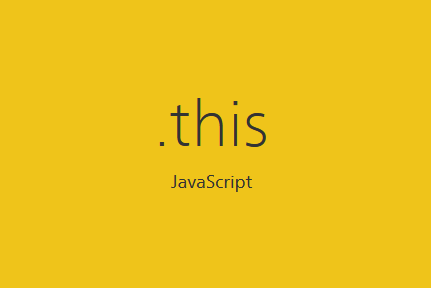The 'this' Keyword in JavaScript
by Nicklas EnvallThe keyword this is something Javascript developers kind of get, but not enough to be comfortable with it. So why not look at how this works so we can become more comfortable?

this is a runtime binding. What this references depend on how a function is called, meaning the binding is created when the function is called.
Analysing the call-site helps us understand what this will reference. The call-site is the place in the code where a function is called (not declared). For example:
function greet() { console.log("hello"); } greet(); // This is a call-site for greet
The four rules of This
Okay great, we now know that we should look at the call-site, but you can call a function in many different ways, right?
Luckily we have 4 rules for how a call-site would determine where this points to. In some cases multiple rules might apply, but we only use one, which is decided by priority:
new > explicit > implicit > default
1. Default Binding
function greet() { console.log(this.x); } var x = "hello"; greet(); // hello
With default binding, this points to the global object. It's called default because if we haven't applied any of the other rules, default binding will occur. If we would have had strict mode, the global context would've been undefined.
2. Implicit Binding
function showAge() { console.log(this.age); } var person = { age: 45, showAge: showAge } var age = 20; person.showAge(); // 45
Here we can see that this uses the person object's context. If we analyse the call-site, we see that the object is used to reference the function when calling it. When we call the function in this way, the function's this becomes the object.
The following similar example might be confusing:
function showAge() { console.log(this.age); } var person = { age: 45, showAge: showAge } var age = 30; var showAge = person.showAge; showAge(); // 30
You would assume that it would've been 45, but it's 30. The reason for this is that person.showAge is just a reference to the function showAge. Remember that we are interested in how we call the function.
3. Explicit Binding
With explicit binding, we can ensure that this points to what we want by using call, apply, or bind.
function foo() { console.log(this.x); } var obj = { x: 100 } foo.call(obj); // 100
In the example above we use explicit binding to force obj to be the this in the foo function.
We can also hard bind, ES5 gives us Function.prototype.bind, which allows us to more easily hard bind.
function foo() { console.log(this.x); } var obj = { x: 100 } var bar = foo.bind(obj); bar(); // 100
If you think about it, using bind can also create some confusion. The example below looks similar to a default binding and someone might scratch their head for a long time wondering why it's logging 100 and not 13.
function foo() { console.log(this.x) } var obj = { x: 100 } var logX = foo.bind(obj); // let's pretend we go 20 lines down var x = 13; logX(); // 100
4. new Binding
In Javascript, there are no specific constructor functions, but there are constructor calls. Calling a function with the keyword new in front of it makes it a constructor call. Commonly, we capitalize the name of a function to mark it as a constructor.
function Person(age) { this.age = age; } var steve = new Person(50); var jessica = new Person(27); console.log(steve.age); // 50 console.log(jessica.age); // 27
Here we have constructed a new object and ensured that the new object is this.
Binding this to Arrow Function
With ES6, we have arrow functions, which many of us like to use. But have you ever been confused why this does not work as you expect it would've when using arrow functions? Like getting undefined when using this?
Well, arrow functions do not follow the four rules they bind this based on scope in javascript. ES6 arrow functions use lexical scoping for determining this.
Function vs Arrow Function
Lastly, I'll give you some code examples that show how a function and arrow function would work in some different scenarios.
Example 1
Let's start with an example of this with a normal function in an object:
var person = { age: 40, printAge: function() { console.log(this.age) } } person.printAge(); // 40
Now the exact same code, but with an arrow-function:
var person = { age: 40, printAge: () => { console.log(this.age) } } person.printAge(); // undefined
Example 2
Before you say "I'll never use arrow functions when creating methods then, I guess?", do consider the following code examples:
var dollarStore = { price: "1$", items: ["Orange", "Soda", "Apple"], getItems: function() { return this.items.map(function (item) { return item + " costs " + this.price; }); } } console.log(dollarStore.getItems()); // ["Orange costs undefined", "Soda costs undefined", "Apple costs undefined"]
var dollarStore = { price: "1$", items: ["Orange", "Soda", "Apple"], getItems: function() { return this.items.map(item => item + " costs " + this.price); } } console.log(dollarStore.getItems()); // ["Orange costs 1$", "Soda costs 1$", "Apple costs 1$"]
If you want to avoid using an arrow-function in this scenario you could save this in a variable like:
var dollarStore = { price: "1$", items: ["Orange", "Soda", "Apple"], getItems: function() { var that = this; return this.items.map(function (item) { return item + " costs " + that.price; }); } } console.log(dollarStore.getItems()); // ["Orange costs 1$", "Soda costs 1$", "Apple costs 1$"]